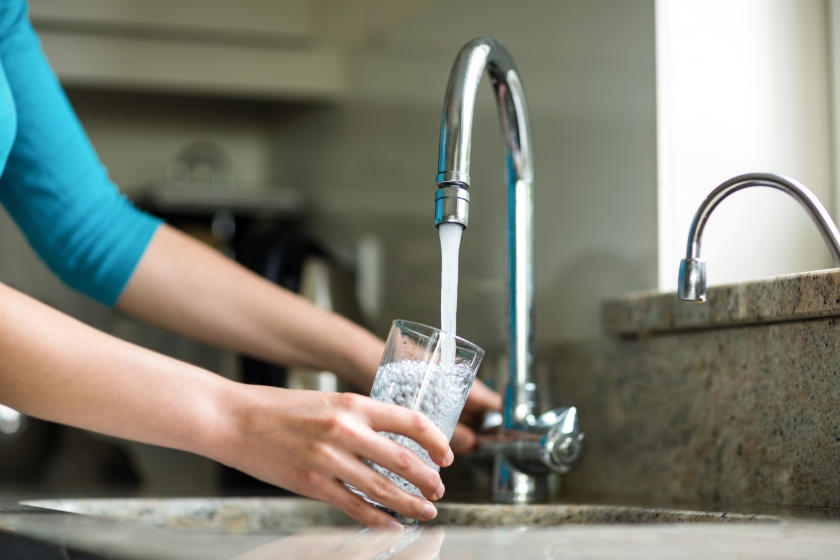Filtering the water in your house softens and makes it taste better — not to mention is healthier for you and your family. It also saves you a small fortune on bottled water.
Install a Whole-House Water Filter
Whole-house water filters trap most sediment and contaminants at the source – before they travel through your pipes. Because this kind of filter connects to the main water line, it improves the water quality throughout your home and lengthens the life of many appliances (such as dishwashers and washing machines). Plus, maintaining one is as easy as maintaining a pitcher filter by simply changing the cartridge every few months.
Note: Because house plumbing varies widely, these are not “one-size-fits-all” instructions for installing a whole-house filter. These are general guidelines for all installations. Your local True Value associate can give you advice and tips for installing a whole-house filter for your specific household plumbing.
Step 1: Turn Off Water Main
Turn off the water at the main valve and drain the system. You can do this by opening the highest and lowest fixtures in the house. The filter should be placed on the main water supply line near where it enters the house (at any point past the main shutoff valve but before pipes branch off).
Step 2: Cut into Main Water Line
Cut a section of the pipe large enough to accommodate the filter you have chosen. Use a handsaw or reciprocating saw with a metal-cutting blade to remove approximately a 6″ section from the main water line. Then smooth the newly cut ends with a steel file to avoid jagged points or edges. Keep a bucket handy to catch water that escapes as you slice through the metal.
Safety Alert!
Take the necessary precautions when cutting metal. Wear protective eyewear and a facemask to protect yourself from any metal shavings.
Step 3: Install the Filter
Install the filter as directed by the manufacturer’s instructions. It’s recommended that you place a shutoff valve immediately on each side of the filter. This prevents a mini-flood every time you change the filter.
To do this, you will need to familiarize yourself with basic pipe soldering techniques. First, make sure the pipe ends and shutoff valve surfaces are clean. You can clean them by scrubbing them with steel wool. Next, use flux (a substance used in soldering to connect two metals) to remove oxides from the interior surfaces of the pipe and valve. This also facilitates soldering. Flux should be applied to the pipe and the valve where it will connect to the pipe. Then, using a soldering wire and blowtorch, melt the wire by placing it against the surface of the pipe where the two pieces are being joined. The blowtorch is applied directly to the pipe to heat it and melt the solder.
Step 4: Turn On the Water
After making the connection, reopen the valve on the filter’s incoming side. Watch the new joints carefully, making sure they don’t leak before opening the other valve and letting water flow toward the rest of the house. Once you open that valve, again watch the new joints carefully for leaks. If a lot of water is escaping, re-solder the joint. Smaller leaks can be sealed off with Teflon® plumber’s tape. Once everything seems to be working, tighten the filter using a wrench. You’ll now get months of pure, filtered water throughout your entire house.
Install an Under-Sink Water Filter
Under-sink filters deliver pure, great-tasting water for cooking and drinking. Once installed, they’re more convenient to use than basic countertop and faucet filters. Because under-sink filters connect directly to the water supply line, the filtered water is available through a separate faucet installed above the sink.
Step 1: Clean Out the Cabinet
You’ll need room to work under the sink, as well as access to the filter after it’s installed, so clear out the cabinet. Later you may want some under-sink organizers, such as rollout racks, to maximize storage without interfering with the filtration system.
Step 2: Find the Cold Water Line
Identify which pipe is the cold water line. If you aren’t sure, turn on the hot water and let it heat up. Feel the pipes with your hand. The pipe that isn’t hot is your cold water line. Turn off the water.
Step 3: Mount the Filter
Position the filter’s mounting base on a sidewall of the cabinet and mark the holes for the mounting screws. Then attach the base, making sure to leave the required room below the unit for changing the filter. The bottom of the filter should be at least 3″ above the bottom of the sink cabinet.
Drill clearance holes for the mounting screws. The bracket should be screwed into a wall stud if possible. Use a stud finder to locate the wall studs. If there isn’t a wall stud available, use hollow-wall anchor bolts or toggle bolts to secure the bracket to the wall. Mount the filter onto the bracket.
The easiest place to install the filter faucet – and the only place if you have a cast iron sink – is in an existing hole, such as the one used for the sprayer or dish soap dispenser. Drilling a stainless steel sink requires a costly plug cutter or step drill bit. You can also drill a one-inch hole in the countertop using a hole saw. Mount the faucet in the hole with a sink wrench as directed.
Helpful Tip
If you don’t want to sacrifice the sprayer, consider replacing your sink faucet with one that has an integrated sprayer. That way, you can still have a sprayer and faucet for the water filter.
Step 4: Tap into Water Line
If your filter has a self-piercing saddle valve, simply screw-clamp it around the cold water line and turn the handle clockwise to pierce the pipe. If the filter comes with a T-adapter fitting, close the cold-water shutoff valve under the sink and remove the riser (the tubing that connects to the sink faucet). Use an adjustable wrench for the compression fitting above the valve and a sink wrench for the fitting at the faucet. Cut out a section of the pipe using a tube cutter and install the compression T-adapter in its place.
Step 5: Complete Tubing Connections
Attach the plastic tubing to the filter, water line and new faucet. Wrap Teflon plumber’s tape clockwise around the male end of any threaded fittings to assure a leak-proof connection. Open the saddle valves or turn on the water to make sure there are no leaks. Then reload the cabinet and you’re all set.
Helpful Tip
If you have an icemaker and it connects to the water supply under the sink or somewhere you can access from under the sink, install a second T-fitting in the line after the filter so it to can be supplied by filtered water.
Install a Faucet Filter
Faucet filters are probably the most commonly used water filters. They’re good for cooking and drinking water and are easy to install. Below are some basic installation guidelines. Be sure to read the manufacturer’s instructions before starting.
Step 1: Remove Faucet Outlet
Unscrew the faucet outlet with channel locks or pliers. If the outlet was attached to external threads, you can probably attach the filter base directly onto those threads. If the outlet has internal threads or a regulator, you will need an adaptor in order to screw on the filter base.
Step 2: Attach the Filter
Wrap Teflon pipe tape around the faucet threads or the threads of any adapter you may need and tighten the adaptor to the faucet head. Screw the filter base onto the faucet head or adaptor. Insert the filter into the base.
Step 3: Run Water
Most filters need a short test period to work the way they should. Run water through the filter for a couple of minutes to remove any sediment and other material. Don’t use the water from this test! Afterwards, the filter should be working properly and you’ll have clean, healthy water right from the tap.
Great job! You have now taken steps to improve the quality of the water in your home.
Faucet Filter
Project Shopping List
Here’s what you’ll need to complete this project successfully.
- Faucet filter
- Channel locks or pliers
- Faucet adaptor (optional)
- Teflon pipe tape
Under-Sink Water Filter
Project Shopping List
Here’s what you’ll need to complete this project successfully.
- Under-sink filter
- Under-sink organizers (optional)
- Drill
- Drill bits
- Stud finder
- Screwdriver
- Hollow-wall anchor bolts (optional)
- Toggle bolts (optional)
- Plug cutter (optional)
- Step drill bit (optional)
- 1″ Hole saw (optional)
- Adjustable wrench
- Sink wrench (optional)
- Tube cutter
- Teflon plumber’s tape
Whole-House Water Filter
Project Shopping List
Here’s what you’ll need to complete this project successfully.
- Whole-house filter
- Filter cartridges
- Handsaw
- Reciprocating saw with metal-cutting blade
- Steel file
- Bucket
- Safety goggles
- Protective facemask
- Two shutoff valves with compression joints
- Steel wool
- Plumbing solder flux
- Soldering wire
- Blowtorch
- Pipe wrench
- Teflon plumber’s tape












